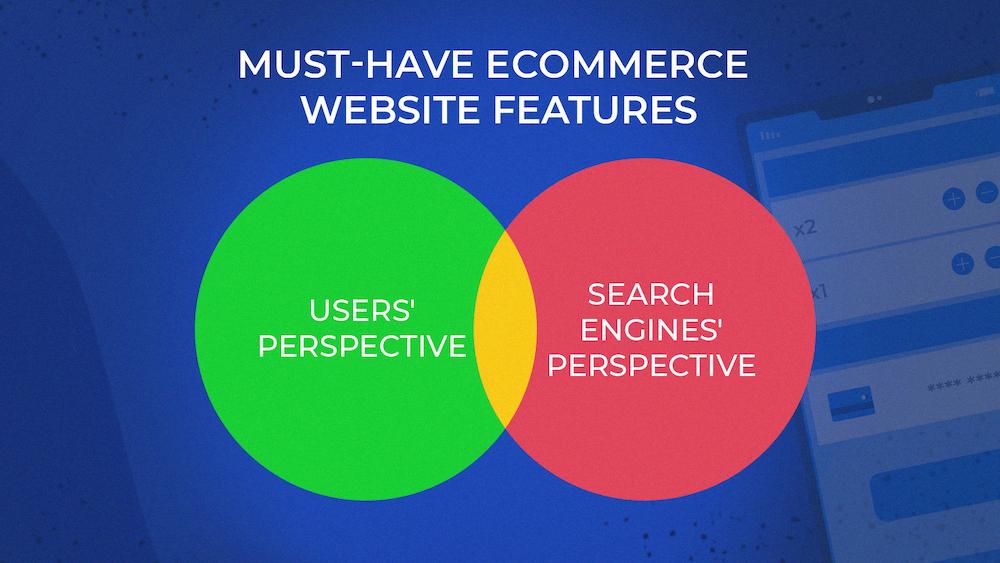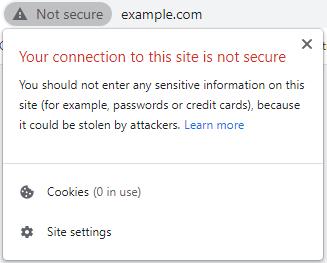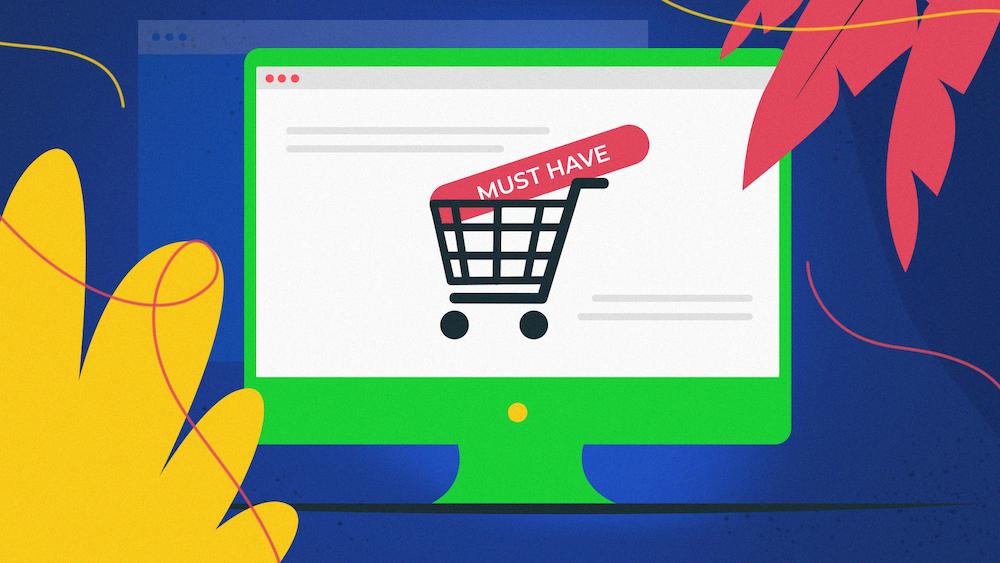With the eCommerce market growing rapidly, it’s estimated that by 2040, 95% of purchases will happen online.
It’s not surprising that the competition out there is harsh. Customers have more options and possibilities to choose from.
Since even a minor detail might influence customers’ decision-making process, it’s essential to put in the extra effort and ensure your site has everything you need to provide a good user experience.
That’s why I’ve created this list of must-have features designed to cover all the elements every eCommerce should include on its website to stay competitive.
How these features can help your website
Users go through a journey to buy a product. Along the way, they might encounter problems that will prevent them from finishing that journey.
That’s where the must-have eCommerce features come into play. They can help your website by making sure that:
- Users can easily find your website in search engines, and
- Your website provides a good experience and encourages users to stay and make the purchase.
Some of the features are SEO-related. They include the technical elements to help search engine bots crawl and index your page and rank high in the search results.
Other features focus on user experience.
User experience (UX) describes the experience users have with a product or service (in the case of SEO, a website). UX looks at how users interact with a product and analyzes their perception of it. It includes factors like:
- Usability,
- Desirability,
- Value of the site.
A great user experience is essential during all of the interactions between a company and a client, but one of the crucial steps for eCommerce is to consider UX when designing a website. It needs to be easy to use and attractive for the users.
Both search engines’ and users’ perspectives are essential to determine all the must-have features.
You may have a website with a great user experience, but it might still be hard to find in a search engine.
Or you may have a site that’s flawlessly optimized for search engines but unhelpful to users.
Optimizing websites for UX and search engines goes hand in hand. That’s why some of the must-have eCommerce features fall into both categories.

Must-have eCommerce features for SEO
Structured data for eCommerce
Structured data helps search engines understand the context of your page better by giving them additional information and clues about your content. Both Google and Bing have guidelines regarding structured data and methods of implementation.
With structured data, besides standard blue links, users can see rich results on the search results page. Their primary benefit is increasing the Click Through Rate (CTR).
Milestone Research studied users’ clicks on SERP. After analyzing 4.5 million queries, the results showed that 41% of searches end with a click on standard results, while users click on rich results 58% of the time.
The type of structured data you need depends on the content of your website, but the two most important ones for eCommerce are:
The Product type allows you to present detailed information about the product on the search result page, for example, its price and availability.
The Review type allows you to show the reviews and combined scores from many users in the form of rating stars. They can be presented as rich results or included in the Google Knowledge Panels.
You can find more valuable types of structured data in Google’s documentation. However, you shouldn’t limit yourself only to the ones recommended for an eCommerce website. For example, you should consider implementing structured data specific for articles if you have a blog section.
Sitemaps
A sitemap is a file that includes information about your pages, images, videos, and the relationships between them. Its purpose is to help search engine bots discover, crawl, and index your website.
Sitemaps are not obligatory, but they are definitely beneficial. Using a sitemap, you can show search engine bots which pages you want to have indexed, and that helps especially if you have a large website.
Remember to follow the guidelines and put only the URLs you want search engines to index in your sitemap.
You can generate a sitemap manually or automatically. However, with a big eCommerce site, having an automated mechanism for generating optimized sitemaps is preferred.
eCommerce pages are dynamically generated, new products appear, and go out of stock. Therefore, keeping your sitemap up to date is an essential step in managing a large eCommerce website.
To generate a sitemap automatically, you can use the built-in options provided by most eCommerce platforms or use a third-party tool. For more information on how to generate a sitemap, you can visit Google’s documentation.
Must-have features for both SEO and users
User-generated reviews
According to Brightlocal, 87% of customers read online reviews.
User-generated reviews are a must-have feature to increase users’ trust in products and encourage them to purchase. Users can closely look at the items in physical stores, but they need to rely on pictures and descriptions when ordering online. That’s why reviews are the most credible source of information about the product that users can find on your website. In fact, if a product has at least five reviews, the likelihood of a customer buying it increases by 270%.
To add user-generated reviews, you can use options provided by your eCommerce platform and allow users to leave them directly or use plugins to integrate third-party platforms like Yelp on your website.
You need to know that user-generated reviews are important for Google, too. In 2021, Google introduced an algorithm update that focused on surfacing pages with high-quality reviews that go beyond the thin content you can find on some pages.
Navigation is essential from both search engines’ and users’ perspectives.
Have you ever visited a website and got frustrated because you couldn’t find the information you needed?
Non-intuitive navigation can negatively affect the user experience and possibly discourage people from using your website.
In addition, search engine bots discover pages by crawling and following links they find. If the navigation isn’t easy for the search engine bots to follow, they may not find some pages on your website. Like a chain reaction, bots won’t crawl and index the content they haven’t found, and consequently, it won’t appear in the search results.
Some of the good practices while designing internal navigation are:
- Include a search bar to help users quickly find what they need on your site,
- Make sure all of the products can be easily found by following internal links,
- Use breadcrumbs to help users and bots understand your website’s architecture better,
- Avoid navigation relying strongly on JavaScript. Bots can’t click or scroll and won’t be able to discover your content if the only way to find it is, e.g., infinite scroll.
Mobile-friendliness
If you want your eCommerce website to succeed, you need to ensure your mobile version works correctly.
In the third quarter of 2020, 71% of the visits to retail websites were through mobile phones, which converted to 56% of online shopping orders in the USA. Additionally, even 40% of the users switch to competitors if the company has a poorly designed mobile version.
Make sure your website looks as good on a mobile phone as it does on a desktop. It means using techniques like Responsive Web Design and analyzing the way your content is rendered on the phone.
A common problem is not adjusting the layout for the mobile users and displaying large product images that push the rest of the essential information down or uploading text that’s too small to read on smaller screens.
Mobile-friendliness is also a ranking factor for both Bing and Google. It means that if your website is not optimized for mobile phones, it might directly contribute to a lower ranking.
You can use tools like Google’s or Bing’s mobile-friendly test to get more insight into your mobile version.
Security
When customers use an eCommerce website, they might need to use their credit card information or home address. So it’s essential to them to feel like they can do it securely.
Security must-have features for eCommerce websites include:
- TLS certificate,
- Payment Gateway Integration,
- Two-factor authentication.
TLS (previously known as SSL) ensures encrypted communication of data between the client and the server. TLS is used in the HTTPS protocol to add a layer of security that HTTP doesn’t provide.
Browsers warn users when they are entering an HTTP website.

The warning might be enough to create a negative experience for the users and keep them away from entering your website. Additionally, HTTPS is considered a ranking factor, so using the HTTP protocol might directly harm your ranking.
You also need to consider implementing Payment Gateway Integrations. It allows you to securely transfer financial details, like credit or debit card information, between your website and the users.
An additional step to enhance security on your site is implementing two-factor authentication. This way, when users log in to their account on your platform, they need to provide two pieces of information to verify their identity. For example, they need to type their password and a code sent to their phone.
Two-factor authentication allows you to protect your users’ accounts by ensuring that the person logging in is really the account’s owner.
Out-of-stock products strategy
Having a bulletproof strategy for handling out-of-stock products is a must-have step you need to consider when starting an eCommerce business. Especially with large eCommerce websites, where the number of products and their availability might change frequently, it’s essential to have a clear strategy for keeping track of out-of-stock products.
The fundamental question is if the product is out of stock temporarily or permanently.
Strategy for temporarily out-of-stock products
Don’t delete or redirect pages with temporarily out-of-stock products. Reversing it when the product is back in stock might confuse Google, and it will take a while before you get your rankings back.
Instead, consider what option would be the most useful for users. For example, they might want to be notified when the product is back in stock again, or maybe you can include information about the possible availability of the product in a different location.
In addition, you should consider options like setting up the ItemAvailability to OutOfStock in your schema markup or allowing people to filter the out-of-stock products in your internal search.
Strategy for permanently out-of-stock products
Dealing with permanently discontinued products might require more work and is highly dependent on the page’s value. The page might be valuable if, for example, there are many external links pointing to it or it generates traffic. The solutions for permanently discontinued products include redirecting to a similar page or setting up a 404 or 410 code.
Nevertheless, remember that redirecting might be confusing for both users and search engine bots. Therefore, you should always notify the users why the redirect is happening and carefully think if you’re redirecting to closely related pages. If you redirect to a page that’s not semantically and functionally related, bots might treat it as a Soft 404, meaning they won’t follow the redirect but treat the original page as “Not found (404).”
Must-have features from the user’s perspective
Filters
Filters help users narrow down the products and find what they are looking for easily. For example, you can apply filters and search only for specific shoe sizes and price ranges instead of looking through all of the shoes on a website.
Hick’s law illustrates how vital filters are for users. It states that the time it takes to make a decision increases logarithmically with increasing choices. Therefore, the more products you have, the longer it will take for users to decide and purchase an item.
So adding the option to filter the products can help your customers browse through your website and find what they need quickly.
Unfortunately, filters can contribute to creating duplicate content. Each time a filter is applied, the criteria are saved in the URL address, causing many different URLs to point to the same product.
A good practice is to add a canonical tag pointing to the product page you want in the index or prevent search engine bots from crawling the filtered URLs by disallowing it in the robots.txt file.
Shopping cart
A shopping cart is a step between the user spotting a product that they like and actually purchasing it. Therefore, providing an easy-to-use and well-designed shopping cart is a must if you don’t want to frustrate your users, causing them to abandon the cart.
When it comes to the shopping cart, there are two significant elements you need to include on your website:
- The “Add to cart” button next to each item, and
- Shopping cart icon in the upper right corner of the page.
Both of the elements should be in a location that’s intuitive to the user.
When a user has already picked the product and is ready to buy, some factors related to the shopping cart design can make or break a purchase.
A well-designed shopping cart should include:
- the number of items the user added to the shopping cart,
- list of products with details, e.g., its price, color, size, quantity,
- option to remove or edit the item,
- shipping information and payment options,
- the total cost of all items with delivery included,
- an easy-to-find checkout button.
Related items
The “Related items” or “You might also like” section is pretty self-explanatory. It’s useful for the users and can possibly increase your sales.
You just need to ensure that the items are actually related to the product. Random products that have nothing to do with the buyer’s intent are confusing rather than helpful.
On a side note, the related items section usually heavily relies on JavaScript, which can cause problems with crawling and indexing. To learn more about it, check out our Ultimate Guide to JavaScript SEO or contact us for JavaScript SEO services.
Detailed and clear information
To build trust in your company, you need to provide transparent information to your customers.
The first step is to provide all the necessary information about the products themselves. The details include good quality pictures, price, availability, and all the item-specific information required for the user to make a successful purchase, e.g., color, size, type, etc.
Additionally, all the general rules of your business need to be transparent and easy to find as well. They include, but are not limited to:
- Return policy,
- Shipping options and costs,
- Privacy policy,
- Contact details.
Don’t hide any information. Hidden extra costs are responsible for 49% of the abandoned shopping cart. If you want the users to have a good experience with your website, make sure all the details are precise.
Additionally, a good way of presenting information specific to your business is to include a Frequently Asked Questions section.
Here’s what you can do now: Still unsure of dropping us a line? Read how technical SEO services can help you improve your website.NEXT STEPS
Wrapping up
Take a closer look at how search engines and users might perceive your site and analyze which features you’re lacking.
Remember that your website needs to be helpful for the users. So make sure it’s easy to navigate, all the essential details are included, and users can access your website from every device.

Hi! I’m Bartosz, founder and Head of Innovation @ Onely. Thank you for trusting us with your valuable time and I hope that you found the answers to your questions in this blogpost.
In case you are still wondering how to exactly move forward with your organic growth – check out our services page and schedule a free discovery call where we will do all the heavylifting for you.
Hope to talk to you soon!








